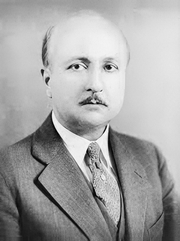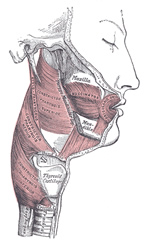The [buccinator] muscle is a flat, thin quadrilateral muscle, that closes the space between the maxillary bone superiorly and the mandible inferiorly. It forms the side of the face and is the main muscular component of the “cheeks”. Etymologically [buccinator] means "trumpeter".
The superior and inferior boundaries of the muscle are the external surfaces of the alveolar processes of the maxilla and mandible on its posterior region, related to the posterior three molars. The posterior boundary is the anterior border of the pterygomandibular raphe, where posteriorly the middle pharyngeal constrictor also attaches. Anteriorly, its fibers appear to continue with the orbicularis oris muscle, but this is not so, as these two muscles (orbicularis oris and buccinator) are separate.
The fibers of the buccinator muscle are divided into three groups: the horizontal group continues anteriorly horizontally. The superior fibers have an anteroinferior direction and converge toward the angle of the mouth. The inferior fibers have an anterosuperior direction. These fibers appear to be continuous with the orbicularis oris, although they terminate in the mucosa, skin and some intermix with the muscular fibers of the orbicularis oris.
The buccinator muscle is covered by the buccopharyngeal fascia, and is in relation by its superficial surface and posteriorly, with a mass of fat (Bichat’s fat pad or suctorial pad), which separates it from the ramus of the mandible, the masseter, and a small portion of the temporalis muscle.
The parotid duct (Stensen’s duct) pierces the buccinator muscle opposite the second molar tooth of the maxilla.
The buccinator muscle receives innervation from the temporofacial and cervicofacial branches of the facial nerve (7th cranial nerve)
Sources:
1. “Gray’s Anatomy” Henry Gray, 1918
2. "Tratado de Anatomia Humana" Testut et Latarjet 8th Ed. 1931 Salvat Editores, Spain
3. "Gray's Anatomy" 38th British Ed. Churchill Livingstone 1995
Image in Public Domain, by Henry Vandyke Carter, MD - Gray's Anatomy, 1918




